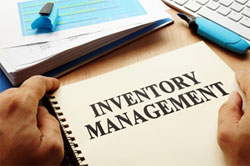 There are many things which tend to annoy customers in a retail, or related setting, including rude or unavailable support staff, difficulty accessing stores in person, finding information online, prices which don’t offer value for money, and so on.
There are many things which tend to annoy customers in a retail, or related setting, including rude or unavailable support staff, difficulty accessing stores in person, finding information online, prices which don’t offer value for money, and so on.
However, something that can really be a detriment to your business because it frustrates customers is having lots of damaged or broken goods, and continually running out of the most sought-after stock. This is particularly damning to clients if they’re led to believe an item is in stock, but then find out it has actually sold out, or never arrived in the first place.
To improve the customer experience and enjoy higher sales to boot, you must find ways to better manage your stock levels (and quality) on a daily basis, and to ensure you and your team handle stock outages in the most effective way possible. Read on for some key inventory-management tips you can follow today.
Use Technology to Track, Analyze and Order Items
You no doubt use technology to simplify and speed up numerous tasks in your organization already, but it’s worthwhile looking into tech options for inventory management too. For example, make sure you’re using feature-rich software that incorporates bar-coding and allows you to get better real-time visibility of your stock levels as a result.
It is also helpful to establish bin-level inventory controls using a warehouse-management system that tracks data each time something comes out of a bin. This allows you to know exactly what you have in stock of each product and in each bay, and means you can implement cycle counting rather than having to spend time conducting full physical inventories all the time.
For optimal inventory management, it’s also important to have stock in the right place at the right time. After all, you don’t want to have lots of a product in one location if another store really needs it, particularly if transport times between the destinations is long. To combat this, combine your inventory management tools with demand management and inventory optimization software so that you can get items where they need to be, when they need to be there. Also, use tech tools to enable staff in different locations to communicate more effectively, and to pass up-to-date information on to customers.
Other tech-related ideas include adding GPS technology (i.e. satellite-based navigation systems) to your inventory management tools so you can track and compile reports on items throughout the supply chain; giving warehouse workers wearable scanning devices for hands-free work that assists with accuracy and control; and utilizing artificial intelligence and machine learning to help improve demand forecasting.
Secure Additional Funding to Increase Stock Levels
 Next, don’t be afraid to secure additional funding for your firm to help you improve inventory management and satisfy customer demand. When you know you have busy times coming up, such as Christmas or other peak periods for your industry or specific business, it’s essential to stock up.
Next, don’t be afraid to secure additional funding for your firm to help you improve inventory management and satisfy customer demand. When you know you have busy times coming up, such as Christmas or other peak periods for your industry or specific business, it’s essential to stock up.
Similarly, if there is one particular product that’s racing out the door, you don’t want to turn customers away, so should place an order for more before your supplier runs out.
Often though, you might not have the cashflow available to pay for these bills. When this happens, you’ll need to get a loan or cash advance, make use of invoice factoring, or otherwise get more money in the kitty quickly.
If you’re worried about a loan application taking too long, keep in mind that these days, thanks to technology, many lenders have been reducing red tape and starting to approve loans quickly, sometimes within just a couple of days. When researching options, look for fintech-based small business loans, so you know the provider has processes in place to speed up application wait-times.
Build Better Relationships With Suppliers
You can also work on having the stock customers want, when they want it, if you build your relationships with suppliers. It’s very important to have reliable suppliers who offer you decent terms, so when you find them, treat them like the precious commodity they are. Be loyal to them, always polite, pay your bills on time, and communicate clearly.
Through developing solid relationships with your suppliers, you will enjoy many benefits. For example, you’ll be better able to negotiate prices and terms, which means you will have more money available to buy more stock, and/or receive it more quickly. You’ll also be higher up the list when it comes to getting access to in-demand products; and you’ll receive quicker notifications about stock availability and delivery times (which you can pass on to customers). You’re more likely to receive quality inventory each time too, and to have fewer problems with returning or exchanging goods as required.
About the Author
Tiffany is a leader in marketing authority who assists Seek Visibility. Tiffany prides herself in her ability to create and provide high quality content that audiences find valuable. She also enjoys connecting with other bloggers and collaborating for exclusive content in various niches. With many years of experience, Tiffany has found herself more passionate than ever to continue developing content and relationships across multiple platforms and audiences.




